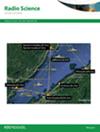Statistical Analysis of Off-Great Circle Radio Wave Propagation in the Polar Cap
IF 1.6
4区 地球科学
Q3 ASTRONOMY & ASTROPHYSICS
引用次数: 0
Abstract
High latitude ionospheric density structures such as polar cap patches and arcs are capable of deflecting high frequency (HF) radio waves to off-great circle paths, and are likely detrimental to technologies dependent on HF radio propagation. In this study, nearly 2.5 years of 4.6–14.4 MHz data from a multi-frequency HF radio link between Qaanaaq, Greenland and Alert, Canada are used to investigate high-latitude off-great circle propagation in the polar cap. After an example of HF radio propagation affected by polar cap patches is shown in detail, a statistical analysis of the occurrence and impacts of off-great circle deflections in the polar cap is presented. Off-great circle propagation is shown to be increasingly common with increasing frequency up to 11.1 MHz, such that averaged over 1 year, received 11.1 MHz signals experienced deflections >30° from the great circle direction 65.6% of the time. The occurrence of these deflections across the year is shown to be at a maximum in the winter, while occurrence across the day varies with season. Trends across both time of day and time of year for 11.1 and 14.4 MHz deflections are consistent with polar cap patch occurrence trends. Off-great circle deflections are shown to be associated with increased time-of-flights, a larger range of positive and negative Doppler shifts, increased Doppler spreads, and lower signal-to-noise ratios. These results are discussed in the context of ionospheric phenomena in the polar cap, and implications for over-the-horizon radars operating at high latitudes.极圈外无线电波在极冠传播的统计分析
高纬度电离层密度结构(如极盖斑块和弧线)能够将高频无线电波偏转到大圆以外的路径,很可能对依赖高频无线电传播的技术造成损害。本研究利用格陵兰岛 Qaanaaq 和加拿大 Alert 之间多频率高频无线电链路近 2.5 年的 4.6-14.4 MHz 数据,研究极冠中的高纬度偏离大圆传播。在详细展示了受极冠斑块影响的高频无线电传播实例之后,介绍了极冠偏离大圆偏转的发生和影响的统计分析。结果表明,随着频率的增加,偏离大圆传播的现象越来越普遍,最高频率可达 11.1 MHz,因此平均 1 年内,接收到的 11.1 MHz 信号有 65.6% 的时间偏离大圆方向 30°。这些偏转的全年发生率在冬季达到最大,而全天发生率则随季节而变化。11.1 和 14.4 MHz 偏转在一天和一年中的发生趋势与极冠斑的发生趋势一致。研究表明,偏离大圆偏转与飞行时间增加、多普勒正负偏移范围增大、多普勒频差增大和信噪比降低有关。在极冠电离层现象的背景下讨论了这些结果以及对在高纬度运行的超视距雷达的影响。
本文章由计算机程序翻译,如有差异,请以英文原文为准。
求助全文
约1分钟内获得全文
求助全文
来源期刊

Radio Science
工程技术-地球化学与地球物理
CiteScore
3.30
自引率
12.50%
发文量
112
审稿时长
1 months
期刊介绍:
Radio Science (RDS) publishes original scientific contributions on radio-frequency electromagnetic-propagation and its applications. Contributions covering measurement, modelling, prediction and forecasting techniques pertinent to fields and waves - including antennas, signals and systems, the terrestrial and space environment and radio propagation problems in radio astronomy - are welcome. Contributions may address propagation through, interaction with, and remote sensing of structures, geophysical media, plasmas, and materials, as well as the application of radio frequency electromagnetic techniques to remote sensing of the Earth and other bodies in the solar system.
 求助内容:
求助内容: 应助结果提醒方式:
应助结果提醒方式:


